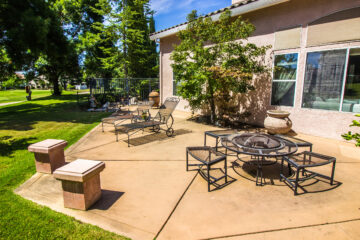For many homeowners, the summer months are ideal for spending time outside and especially for creating new outdoor entertaining spaces. Outdoor concrete surfaces, such as patios, porches and pool surrounds, are the perfect areas to congregate and enjoy beautiful weather, holidays and time with family. Are you thinking about adding a new concrete area or are you concerned about protecting your current concrete pad from potential damage caused by direct sunlight or high temperatures? Read on to find out ways you can create or maintain concrete surfaces all summer long.
How Do You Protect Your Concrete in Hot Weather?
Concrete surfaces, such as sidewalks, driveways and patios can get extremely hot during the summer months. While concrete is designed to last and withstand harsh weather elements, it is still important to take good care of your concrete. Extremes in temperature changes can lead to cracks and damage and if you have stained concrete, it can become faded by the sun. Fortunately, it isn’t difficult to keep your existing concrete surfaces protected from heat and sunlight if you follow this annual routine.
1. Clean the Area Annually
Regularly cleaning the concreate areas at your home can help to prevent chipping and discoloration and it helps with basic aesthetics as well. Your existing concrete pads, sidewalks and driveways that have been fully cured can be cleaned using either a broom and dustpan or by rinsing them with a hose. This gentle method ensures that you don’t accidentally damage the concrete yourself. However, for bigger, more heavy-duty cleaning jobs, you can use a power washer. You’ll want to make sure that it is on the lowest setting so that you don’t accidentally chip away the top layer of concrete. You can even use a small amount of liquid detergent and a push broom to scrub extra dirty areas.
2. Add a New Coat of Sealant on a Regular Basis
If your concrete had an initial layer of sealant put down when it was first poured, chances are it has worn away. Unfortunately, sealant isn’t a one-and-done job that you don’t have to maintain. Depending on the quality and type of sealer, reapplying a layer every three to five years can help protect your concrete from harsh weather, including extreme heat and direct sunlight.
The amount and frequency of sealing you’ll want to do will also depend on the area in which your concrete is located. If it gets a lot of foot or vehicle traffic or if it’s exposed to constant, direct sunlight during the day, it will likely need sealant reapplied more often. If it’s a shaded area or doesn’t see much use, you can go longer between reapplications.
3. Remove Stains Before They Are Absorbed
Driveways and sidewalks are especially susceptible to concrete stains, including oil, grease or other chemicals from vehicles or lawn equipment. It is important to remove these stains as soon as possible to prevent them from being absorbed into your concrete. Areas where the sun beats down on the concrete are the quickest to get stained, as the heat practically bakes in the stain. There are stain-removing products that are specifically made for concrete that you can use to get rid of any issues, if you use them soon enough. The moment you notice staining, start cleaning. If you don’t notice the stain right away, still use the stain remover as you’ll likely be able to at least reduce the discoloration.
When it comes to concrete maintenance, protection, cleaning, stain removal and sealants, our team at Intermountain Concrete Specialties can be a great help. Don’t hesitate to Contact us for help.
How Do I Keep My Concrete Patio Cool in the Summer?

Depending on the direction your home faces, your concrete patio may have the hot summer sun beating down on it all day, which makes it difficult to enjoy spending time there. Even when the sun has gone down, the concrete may still have radiant heat that makes it uncomfortable. If this is the case at your residence, here are a few ways to keep your concrete patio cool, even when it’s hot outside.